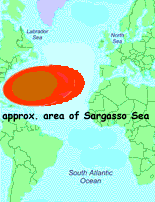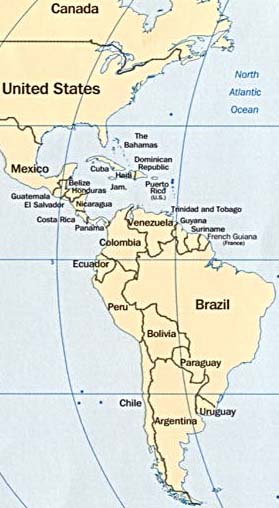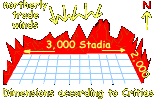|
If possible, please take the time to run an eye over the translated texts Timaeus and Critias.
The Genisis
Plato wrote the first of the two dialogues (Timaeus) around 355 BC. The participants
are Socrates - Plato's friend and mentor, Timaeus - an Italian astrnomer,
Hermocrates - a Syracrusan general and Critias - Plato's ancestor. The
dialogue as a whole discusses the mechanics of the universe and the physical
world.
It is quite near the beginning that Critias relates a childhood story
told to him by his grandfather of the same name, who had himself been
told the story by his father Dropides, who'd learned of it from another
relative - Solon (638-558 BC). A known historical fugure, Solon is said
to have visited Egypt during the reign of the Pharaoh 'Amasis' (Aahmes
II). though there is some doubt that Solon visited Egypt at this time,
it is known that he did at some point got to Egypt.

On entering the temple of Minerva (Patron goddess of Sias). Solon is
said to have had a conversation with an old priest. As Solon speaks of
the previous destruction of humanity, the priest chastises him for knowing
so little...
".....you Greeks are always children; in Greece there is no such thing
as an old man....You are all young in your minds....which hold no store
of old belief based on long tradition, no knowledge hoary with age."

Telling Solon that Man had been destroyed many times, "the greatest by
fire & water", he derides the history of the Athenians as "little better
than nursey tales". It is also explained that though the Athenians remember
one deluge, there were many and that they are actually descended from
a race of "brave and noble" men. That before the greatest deluge, Athenians
are recorded in Egyptian temple records as defeating a great power which
"insolently advanced against all Eurpoe & Asia, starting from the Atlantic
Ocean outside.." The story of this island power is related in about 50
lines in the Timaeus while the whole of the Critias is dedicated to its
history.
The Impassable Sea
After establishing that the island was situated beyond the Pillars of
Hercules (the Strait of Gibraltar), the priest clarifies that in those
days, "the ocean could be crossed" i.e. the island was accessible by ocean-going
vessels. We are then told that after its destruction by 'earthquakes and
floods', the outer ocean could no longer be "crossed or explored, the
way being blocked by mud just below the surface, left by the setting down
of the island."
This reference to a sea of mud is found in the works of several other
ancient writers e.g. Aristotle tells us in 'Meteorologica' that the water
outside the Pillars of Hercules is "shallow because of mud, but calm".
A century before Plato, a Latin historian Rufus Festus Avienus wrote:

"...the Carthaginian Himilco asserts that [the waters beyond the Pillars]
can barely be crossed in four months, as he reported himself to have proved
by sailing.... That among the shoals much seaweed sticks up and in the
manner of a thicket holds back the ship. He says moreover that here the
back of the sea does not go down deep, and the [ocean] floor is barely
covered by a small amount of water. The wild creatures of the sea are
always appearing here and there and among the slow ships...sea monsters
swim."
These unquestionable refer to the Sargasso Sea, a vast region of the
Atlantic (approximately that size of Europe) that stretches between the
Azores and the Bahamas. This entire area is one body of seaweed! It's
origin remains unknown and was once thought to have broken away from the
American mainland, but marine biologists have discovered that it is infact
indigenous to the region & reproduces without any connection to the mainland.
Officially, Columbus was the first to discover this phenomenon, recording
on 16th September 1492 that the surface became "covered with a great mass
of yellowish green weed". This made him think he was approaching land,
but there are no mud banks or shalows beneath the Sargasso Sea. Indeed,
hydrographic surveys show that the depths plunge to between 1,500 and
7,000 metres. He also records large fish here which came close enough
to the boat to be harpooned and cuaght by the crew of one of the ships.
However, could the acceptance by ancient mariners of a 'shallow sea'
and 'mud banks' refer to the area on the other side of this sea of weed?
The shallows of the Carribean stretching for several hundred kilometres
from the Great Bahama to Cay Sal take their very name from the Spanish
words 'baja mar' meaning 'shallow sea'. Could thses ancient writers have
had some knowledge of the Carribean sea?
Plato's reference to "other islands" placed beyond Atlantis, enabling
"voyager" to reach the "opposite continent" is stunningly accurate in
its description of how post-Columbian travellers used the Carribean island
chains as "stepping stones" to the American continent. could they have
been used in the same manner by earlier "voyagers"?
The Opposite Continent
Some consider that the landmass Plato is alluding to, when he described
Atlantis as being the size of Libya and Asia together was actually the
American mainland. the not inconsiderable drawback to this is that Solon
is told "from it [Atlantis], the voyagers of those days could reach the
other islands, and from these islands the whole of the opposite continent".
Now, according to established historical 'fact', America wasn't discovered
till Columbus'1492 trip. [This is of course ignores the Viking settlements
in Newfoundland, established c.1000 AD.]
Yet Plato, seemingly, wasn't alone in his awareness of this other continent.
Circa 300 BC, a work falsely attributed to Aristotle - 'De Mundo' - reveals:

".. it is probable that there are many other continents seperated from
ours by a sea that we must cross to reach them, some larger and others
smaller than it, but all, save our own, invisible to us."
• Could these allusions, among others, to an opposite ontinent
come from knowledge circulating ancient maritme circles?
• Who might this knowledge have come from?
• Who were these transatlantic voyagers who kept their dicoveries
under wraps?
Solon is told that the monarchy of Atlantis ruled not only the island
but many of the islands and parts of the opposite continent. This is unambiguous
enough, but more confusing is the assertion that they also held sway "within
the Straits" i.e. in the Mediterranean as far as Egypt and Greece.
This claim throws a dark shadow over the factual credibilty of the tale.
Dates
Futher problems arise from the issue of dating the Atlantean empire and
its destruction. The first comes when the preist says that Athens was
founded 1,000 years before the 'institution' of Egypt's Sacred Registers
whcih are said to go back 8,000 years. As solon visited Egypt c.570 BC,
this puts the foundation of Athens at c. 9570 BC.
Historians will inform us that in 9570 BC, civilisation hadn't begun.
Man's transformation from nomadic hunter-gatherer to Neolithic farmer
is said to have happened in the Near Far East at the end of the last Ice
Age c. 9000-8500 BC.
So did Plato just pick the date out of thin air? Where could they have
come from?
It is known that the greatest philosophy taught at the Athenian schools
was derived from the mystery schools of Egypt. Egyptian King lists often
contain enormous time periods e.g. the Royal Canon of Turin tells us how
a semi-devine race called the Followers of Horus reigned in Egypt for
13,420 years before the first Pharaoh c. 3100 BC.
By suggesting that the Athenians are 1000 years older than the Egyptians,
Plato was perhaps trying to boost their antiquity. It was after this 9570
BC date that Atlantis is said to have threatened Athens, indeed as the
island power also threatened Egypt, this would put the war with Athens
after c. 8570 BC.
These dates [Timaeus] are however contradicted in 'Critias' which tells
us that the war happened 9,000 years before the dialogues i.e. 9421 BC.
This is not a good start as it leaves a glaring gap of 1,000 years for
the war from one text to the next.
Timaeus then crucially reveals that after the war:
"there was a time of inordinate earthquakes and floods; there came one
terrible day and night, in which all your men of war were swallowed bodily
by the earth, and the island of Atlantis also sank beneath the sea and
vanished".
This fantastic statement suggests that a mighty cataclysm occured post
8570 BC, destroying Atlantis as well as the Athenian soldiers. Unrecorded
by history - could such an event have happened?
Impossible Dimensions
Another area of conflict is the size of Plato's island. He originally
[Timaeus] tells us that it is as large as Libya [all of North Africa west
of Egypt] and Asia [from Egypt to India] combined. A landmass that would
not even fit into the Atlantic ocean!
Then in 'Critias' the large irrigated plain that makes up the main body
of the island, protected from the north by a mountain range, is said to
measure 3,000 by 2,000 stadia (552 by 368 kilometres). Even if this mountain
range is given the width of the mighty Himalayas, it means the island
couldn't have been more than 600 kilometres wide.

Even if we don't take the measurements literally, the discrepancy is
too huge to be ignored. Could one of Athens' most celebrated writers have
really been guilty of such gross incompetence? Perhaps not.
Ignatius Donnelly, american author of 'Atlantis: The Antediluvian world'
(1882), included a translation of the 'Critias' in his work which throws
a new and vitally important light on the Libya/Asia issue.
".....the Kings of the islands of Atlantis, which, as I was saying,
once had an extent greater than that of Libya and Asia......"
The accuracy and origin of this translation is unknown as 19th century
authors often did their own translations from classical texts, and it
possible that Donnelly had access to an authentic Greek text. However,
this wording suggests that what Plato wanted to convey was the area
over which atlantis and it's other islands held sway, not the dimensions
of the island itself.
Conclusion
Because of its immense time-frames and inconsistencies, most historians
dismiss Plato's story as fiction or at best a fictional story based on
the memory of the volcanic destruction of the island of Thera c. 1628
BC in the Aegean.
In the Critias, Plato describes an idealistic island kingdom whose rise
to power and demise undoubtedly reflect what Plato saw happening in Athens.
More than a century before Plato, the Greek nation states, led by Athens,
were fighting both the Persian Empire and the Carthaginians whom they
defeated in great naval battles in 480 BC. Following victory, Athens had
a golden age of growth which ended with a decline into corruption and
decadance. These Athenian political elements need to be stripped away
from the core Atlantis story. As do the clrear infuluence of other mediterranean
cities and histories e.g. cultural similarities between Athens and the
Minoans of Crete such as bull worship.
In the search for Atlantis, it is often forgotten that Plato's story
is supposed to be fiction. He was neither a geographer nor historian but
a writer with an audience of statesmen, politicians as well as philosophers.
He had every right to incorporate his political ideals and embellish whatever
knowledge he had of a prehistoric Atlantic island kingdom.
It is the job of the modern historian to strip away this bias and trace
the outline of the original tale via other sources. If we look at the
bones of the story what do we have?
An island kingdom which flourished in the Atlantic thousands of years
before recorded history, was linked to the American continent via a series
of islands and was accessible to ancient voyagers. It was destroyed by
earthquakes and floods and an 'impassassable sea' of mud and shoals occupies
its former position, preventing further navigation to the opposite continent.
Source: Gateway to Atlantis by Andrew
Collins
|